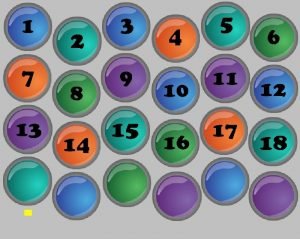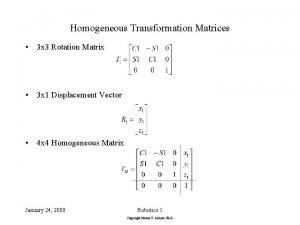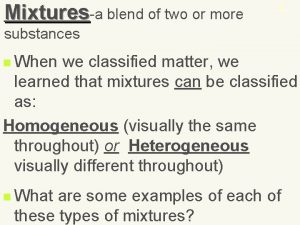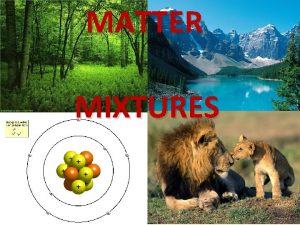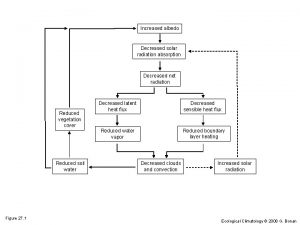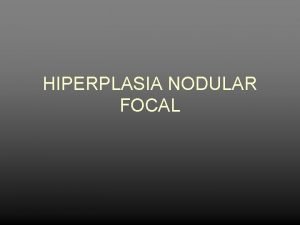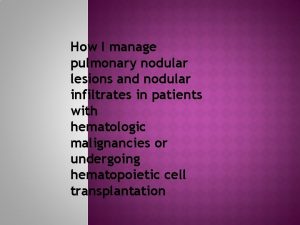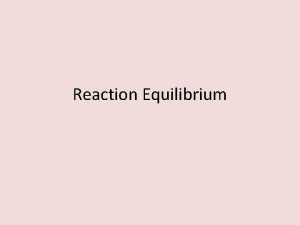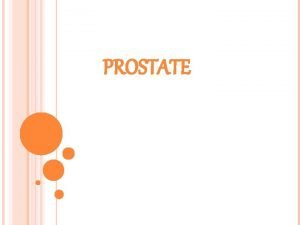Normal Increased Decreased Homogenous Heterogenous Nodular Normal smooth









- Slides: 9

Normal Increased Decreased Homogenous Heterogenous Nodular Normal, smooth Irregular Size Shape/ Contour Echotexture Thyroid Ultrasound. Progressive thinking Mind Map Normal Increased Decreased Vascularity Echogenicity Focal Nodules Cystic- simple, complex Solid- echogenicity, homogeneity, definition Mixed- proportion cystic and solid, definition Hyperechoic Hypoechoic

Size • A normal thyroid gland lobe ranges from between 40 -60 mm long and 12 -15 mm in AP diameter in an adult and increases with age until adulthood (Braverman and Cooper 2012, pp. 25, 184) • An enlarged thyroid gland can be due to overstimulation of the hormones, such as in Graves’ Disease (hyperthyroidism), when there are nodules present, in thyroiditis and when the body is iron deficient • A small, atrophic thyroid gland can be due to chronic thyroiditis or prolonged disease such as hypothyroidism • Images to the right illustrate the correct technique for measuring the thyroid longitudinal and trans Malago et al 2008, pp. 1727

Echotexture Figure 1 illustrates the thyroid from a 34 year old female who presented with mildly raised serum thyroxine (T 4). This representative transverse thyroid image demonstrates a gland that has an echogenicity brighter than the surrounding tissues and vessels and a homogenous, smooth echotexture and contour. There were no nodules within this gland size and vascularity were normal. Figure 2 is the transverse thyroid gland image of a 24 year old female with a history of hashimotos thyroiditis- an autoimmune disease which is often a hereditary condition with a strong predilection for females (Di Muzio & Weerakkody et al, n. d. ). Recently the patient had noticed a generalised anterior neck swelling and pressure on her throat. The figure demonstrates a diffusely heterogenous thyroid that is almost isoechoic to the surrounding tissue. The isthmus is thickened and the gland was noticeably enlarged but there was no well-circumscribed lesions or cystic/colloid nodules visible. Figure 3 is the thyroid of a 43 year old male who had noticed a specific lump that was increasing in size on the anterior right side of his throat. He had no family history or medical history of any thyroid issues, his thyroid hormone levels were normal and he had no pain or other symptoms. When scanning, as demonstrated by the image, a mixed echogenicity well-circumscribed nodule could be seen in the right lobe of an otherwise homogenous thyroid gland.

Vascularity • Normal- The thyroid gland is supplied by the superior and inferior thyroid arteries and consequently should demonstrate some vascularity when colour frequency is high and the scale is low • Hypervascular- Increased vascularity in an otherwise normal thyroid or in a heterogenous and sometimes bulky thyroid usually indicates acute thyroiditis (Kharchenko et al 2010, pp. 69). Another cause of hypervascularity can be nodules. • Hypovascular- Decreased vascularity indicates reduced flow which usually correlates with an underactive gland or hypothyroidism (Kharchenko et al 2010, pp. 67)

Focal Lesions When examining focal lesions of the thyroid you must consider internal contents, echogenicity, a halo, margins, calcifications and vascularity in order to determine nature of lesion (See Table 1 for differentiation). Soto et al 2010 Mittal et al 2012

Feature Benign Malignant Internal Contents Purely cystic Cystic with thin septa Mixed cystic and solid Comet-tail Artefact ++++ +++ + + ++ + Echogenicity Hyperechoic Isoechoic Hypoechoic ++++ +++ +++ Halo Thin alo Thick incomplete halo ++++ +++ Margin Well-defined Ill-defined +++ +++ Calcification Eggshell calcification Course calcification Microcalcification ++++ ++ + + ++++ Doppler Peripheral flow Internal flow +++ +++ Table 1 - Reliability of Sonographic Features in the Differentiation of benign and Malignant Thyroid Nodules. (Rumack et al 1998, pp. 718)

Echogenicity • The thyroid gland should be more echogenic (brighter) than the surrounding tissue and differences in this echogenicity can indicate pathology (Braverman & Cooper 2012, pp. 311) • An echogenic thyroid, where the tissue appears abnormally bright can indicate hyperstimulation of the gland due to hormone imbalance • A hypoechoic thyroid is often an indicator of decreased thyroid function, most likely due to chronic disease

Shape/Contour • The thyroid should have a smooth contour, and be oblong shaped with the long axis tracing the direction of the trachea • When abnormal, the gland can appear lobulated- this can occur due to nodules or changes in internal architecture of the gland when it undergoes fibrotic change (Mestman, 2015)

References • • • Braverman, LE & Cooper DS 2012. Werner & Ingbar’s The Thyroid- A Fundamental and Clinical Text. Lippincott Williams & Wilkins: Philadelphia USA. Kharchenko, VP, Kotlyarov, PM, Mogutov, MS, Alexandrov, YK, Sencha, AN, Patrunov, YN & Belyaev, DV, 2010. Ultrasound Diagnostics of Thyroid Diseases. Springer: New York. Malago R, D’Onofrio, M, Ferdeghini, M, Mantovani, W, Colato, C, Brazzatrola, P, Motton, M & Mucelli, RP, 2008. Thyroid Volumetric Quantification, J Ultrasound Med, vol. 27, pp. 1727 -1733 Mestman, JH, 2015. Disorders of the Thyroid Gland. Available from https: //www. glowm. com/section_view/heading/Disorders%2520 of%2520 the%25 20 Thyroid%2520 Gland/item/307. Accessed 01 October 2015. Mittal, MK, Malik, A, Sureka, B and Thukral, BB, 2012. Cystic Masses of the Neck. IJRI, vol. 22(4), pp. 334 -343 Soto, GD, Halperin, I, Squarcia, M, Lomena, F and Domingo, MP, 2010. Update in thyroid imaging. The expanding world of thyroid imaging and its translation to clinical practise. Hormones, vol 9(4), pp. 287 -298




